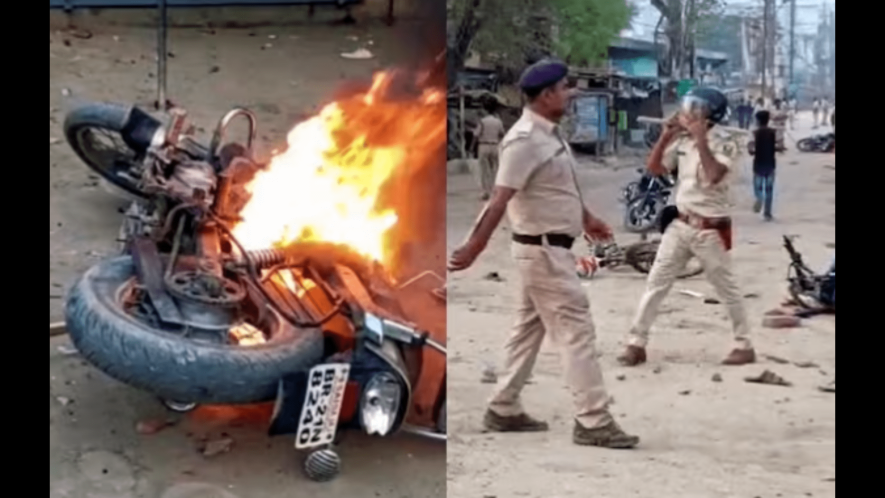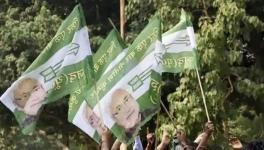Is Bihar Taking the Hindutva Push Lightly?

Police personnel maintain law and order after clashes during a Ram Navami procession, in Nalanda district, Bihar. Image Courtesy: PTI
While the Ram Navami processions that spark communal incidents are being noted across India, incidents that do not get as much attention are also tearing apart the country’s social fabric. Many of these incidents, sparked by Hindutva right-wing elements, occur regularly in Bihar than are nationally noticed. Take a series of recent events. On 22 March, Bihar celebrated the 111th year of its inception, which happened to be the same day as the start of the Hindu new year. For the dual celebrations, the roads and lanes of many towns were heavily decorated, adding to the State’s beauty.
But the day also highlighted a significant and growing threat to the legacy of the founders of the State. At a ground in Darbhanga’s Maulaganj area, saffron flags with “Hindu Rashtra” written on them were raised on roads and placed as banners on homes. The local police blamed “anti-social elements” and filed cases against a few known and dozens of unknown people in this case. On 25 March, Rajeev Prakash Madhukar, the Darbhanga district secretary of the Hindutva group Vishva Hindu Parishad was arrested for trying to put up the banners. The local Bharatiya Janata Party defended Madhukar and accused the Bihar government of appeasing “a community” and being anti-Hindu, the usual allegations of the right-wing Hindu outfits.
It was ironic and tragic that flags of a communal flavour flew in Darbhanga. For, apart from being the heart of Mithila, since the late 19th century, it has been the core of the development of Urdu literature in Bihar. It is one of Bihar’s most important centres of culture and literature, which incidentally started functioning as an independent state on 1 April 1912. Darbhanga’s raja, Kameshwar Singh Bahadur, changed the design of his fort so that a mosque would not be disturbed. Later, he donated land to establish a madrasa in front of the mosque. A better example of harmony and coexistence would be hard to find, yet this town is being turned into a playground for Hindutva politics.
In 1964, historian PC Roy Chaudhury wrote in Bihar District Gazetteers: Darbhanga that the town and district got their name from “the traditional founder of the town—Darbhangi Khan—about whom little or nothing is known”. There are other claimants to Darbhanga’s name. For example, it might have emerged as Dwar-Bengal (roughly translated as Gate to Bengal). However, this claim is not considered accurate. Even if the widely-accepted claim about Darbhanga Khan is not entirely true, in popular culture, his name is always invoked as the one whose name was given to Darbhanga. It is also said that Darbhanga was given to Rahem Khan by Nawab Ali Vardi Khan of Bihar, Bengal and Orissa as a jageer. He defended Darbhanga during the Maratha attacks and lies buried in a deserted tomb at Raham Ganj, named after him.
Though much has been written about Darbhanga city, a lot remains ignored. Munshi Bihari Lal Fitrat, one of the most renowned classical poets of Bihar, who penned Aayina-i-Tirhut or Mithila in the 19th century, was from Darbhanga. Sheikh Hashmat Ali alias Mulla Jan, the mentor of Zeibunnisa, daughter of the sixth Mughal emperor Aurangzeb, was from Darbhanga. The princess was imprisoned in the Salimgarh Fort for about twenty years by Aurangzeb and died in custody in 1701 AD. Mulla Jan is lost in the pages of history, as is Zeibunnisa’s grave at Tees Hazari. But their legacies live on as the Persian poems she wrote under a pen name, Makhfi. They were compiled and published as Deewan-i-Makhfi years after her death.
Several others—Murshid Hasan Kamil, Badri Nath Shabnam, Ayodhya Prasad Bahar, Bhawani Prasad Hasrat, Abd Al-Hayi Zabeeh and Mahadev Prasad Manzar made Darbhanga the abode of multiculturalism. Prof Ijtaba Hussain Rizvi, Pro-V-C, Lalit Narayan Mithila University, and his son, Dr Murtaza Azhar Rizvi, have given their blood and sweat to safeguard this syncretic legacy. Darbhanga is where the eldest grandson of the last Mughal emperor, Mirza Zubairuddin Bahadur Gorgan, rests in his tomb, commissioned by Maharaja Rameshwar Singh.
Bihar was supposed to be the realisation of a century-old secular dream. And it has had five mob lynchings in March this year, continuing a recent trend. A man in his late fifties was thrashed by a mob so severely that he succumbed to his injuries the next day. It was the mere suspicion and allegation of carrying beef that took his life. People once participated in each other’s joys and sorrows. They now have the blood of their own people on their hands.
The first call for an independent Bihar came from the Urdu newspaper, Murgh-e-Sulaiman, in the 1870s. And even till recent times, Bihar’s existence is an example of pluralism and coexistence shaped by the likes of Sir Ali Imam, Dr Sachidanand Sinha, Deep Narayan Singh, Sir Muhammad Fakhruddin, Mahesh Narayan, Mazharul Haq and Syed Hassan Imam.
Bihar has turned away from the days of Rai Sultan Bahadur and Badshah Bahadur, who marked Muharram together, or those of Nawab Nejat Hussain Khan Bahadur Ashki’s days, who took part in Chatth preparations at Doolighat.
Chief Minister Nitish Kumar has taken Bihar to a point where its architectural heritage is being demolished under the development banner. Anything that survives from its past is already hanging by a thread. It is heart-wrenching that Bihar is being reduced to stories of a glorious multi-cultural past while the Hindu Rashtra flag waves over the remnants of history.
The author is a theatre artist, activist and student of preventive conservation. The views are personal.
Get the latest reports & analysis with people's perspective on Protests, movements & deep analytical videos, discussions of the current affairs in your Telegram app. Subscribe to NewsClick's Telegram channel & get Real-Time updates on stories, as they get published on our website.
























